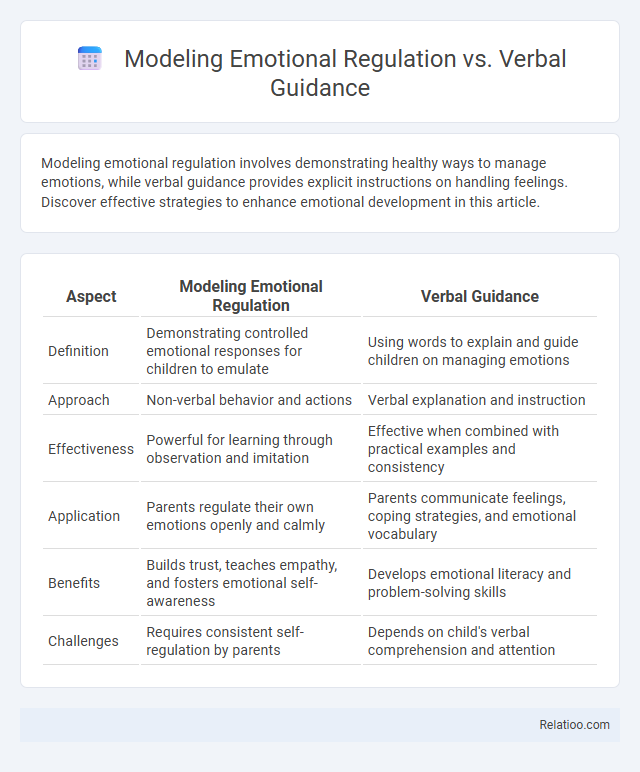Modeling emotional regulation involves demonstrating healthy ways to manage emotions, while verbal guidance provides explicit instructions on handling feelings. Discover effective strategies to enhance emotional development in this article.
Table of Comparison
| Aspect | Modeling Emotional Regulation | Verbal Guidance |
|---|---|---|
| Definition | Demonstrating controlled emotional responses for children to emulate | Using words to explain and guide children on managing emotions |
| Approach | Non-verbal behavior and actions | Verbal explanation and instruction |
| Effectiveness | Powerful for learning through observation and imitation | Effective when combined with practical examples and consistency |
| Application | Parents regulate their own emotions openly and calmly | Parents communicate feelings, coping strategies, and emotional vocabulary |
| Benefits | Builds trust, teaches empathy, and fosters emotional self-awareness | Develops emotional literacy and problem-solving skills |
| Challenges | Requires consistent self-regulation by parents | Depends on child's verbal comprehension and attention |
Introduction to Emotional Regulation and Verbal Guidance
Emotional regulation involves managing your feelings effectively to respond appropriately in various situations, playing a crucial role in personal development and social interactions. Verbal guidance emphasizes explicit communication, where caregivers or educators use clear instructions and explanations to support emotional understanding and regulation. Modeling, in contrast, demonstrates desired behaviors non-verbally, allowing individuals to learn emotional responses through observation rather than direct instruction.
Defining Emotional Regulation in Child Development
Emotional regulation in child development refers to a child's ability to manage and respond to emotional experiences in a socially acceptable way, balancing emotional intensity and expression. Modeling emotional regulation involves caregivers demonstrating appropriate emotional responses, serving as behavioral templates for children to imitate. Verbal guidance complements this by explicitly teaching children strategies to recognize, understand, and control their emotions, enhancing their internal self-regulation skills.
Understanding Verbal Guidance Strategies
Verbal guidance strategies in emotional regulation emphasize clear communication techniques that help individuals identify, label, and manage their emotions effectively. These strategies include the use of empathetic language, prompting self-reflection, and providing specific instructions to reframe negative thoughts. Research shows that combining verbal guidance with modeling enhances emotional competence by reinforcing cognitive understanding alongside observed behaviors.
Comparing the Effects on Social-Emotional Skills
Modeling Emotional Regulation demonstrates significant improvements in children's ability to manage their own emotions, fostering empathy and resilience more effectively than Verbal Guidance alone. While Verbal Guidance provides clear instructions, it often lacks the impactful, nonverbal cues that modeling offers, making Modeling a more immersive method for enhancing social-emotional skills. Your choice to incorporate Modeling Emotional Regulation could lead to stronger, longer-lasting social-emotional development compared to relying primarily on verbal explanations.
The Science Behind Modeling Behavior
Modeling behavior leverages observational learning, where individuals imitate actions, emotions, and reactions demonstrated by others, making it a powerful tool in emotional regulation training. Neuroscientific studies reveal that mirror neurons play a crucial role, enabling observers to internally simulate and understand modeled emotional responses, thereby facilitating empathy and self-regulation. Compared to verbal guidance alone, modeling provides a multisensory and experiential learning process that strengthens neural pathways associated with emotional control and adaptive social behavior.
Benefits of Verbal Guidance in Learning Contexts
Verbal guidance enhances learning by providing clear, explicit instructions that help You understand complex emotional regulation strategies more effectively than modeling alone. It engages cognitive processing through language, enabling learners to grasp the rationale behind actions and apply techniques independently. Benefits include improved retention of skills, immediate feedback opportunities, and reinforcement of adaptive emotional responses in diverse contexts.
Limitations of Each Approach
Modeling emotional regulation often overlooks individual differences in emotional processing, limiting its effectiveness across diverse populations. Verbal guidance may fail when abstract instructions lack practical application or when learners struggle with comprehension or motivation. Pure modeling can lead to imitation without understanding, risking superficial adoption of behaviors without internalized emotional skills.
Integrating Both Methods in Parenting and Education
Integrating emotional regulation modeling with verbal guidance enhances your child's ability to understand and manage feelings while developing critical communication skills. Combining these approaches fosters emotional intelligence and social competence by demonstrating appropriate behaviors and providing clear explanations. This blended strategy creates a supportive learning environment that encourages empathy, self-control, and effective expression.
Practical Tips for Parents and Educators
Modeling emotional regulation teaches children how to manage feelings by demonstrating calm responses during stress, which can be more impactful than verbal guidance alone. Verbal guidance provides clear instructions and explanations, helping children understand emotions cognitively, while combining both methods reinforces learning. You can effectively support your child's emotional development by consistently modeling self-regulation behaviors and offering gentle verbal reminders to articulate feelings and coping strategies.
Conclusion: Choosing the Right Approach for Emotional Growth
Selecting the right approach for emotional growth depends on Your child's temperament and the context of learning. Modeling emotional regulation offers a powerful example of managing feelings through actions, while verbal guidance provides explicit instructions and explanations. Balancing these strategies can create a comprehensive framework that fosters deeper emotional understanding and resilience.

Infographic: Modeling Emotional Regulation vs Verbal Guidance
 relatioo.com
relatioo.com